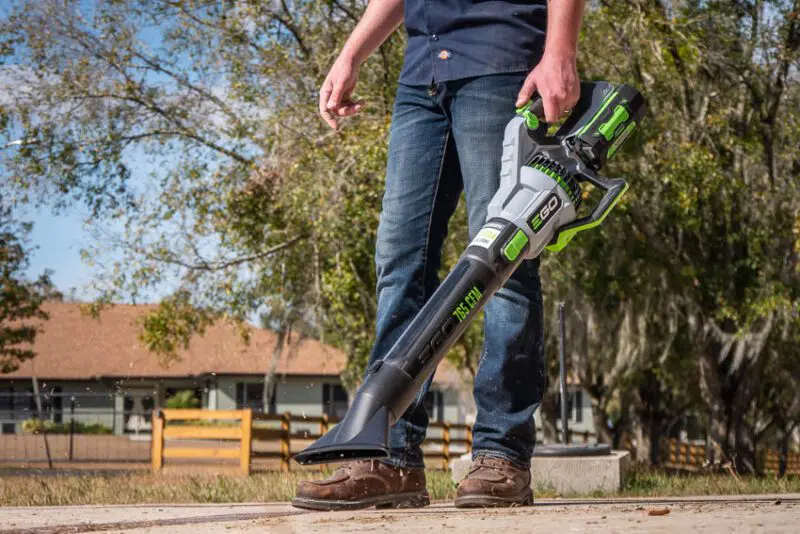You’ve seen the commercials bombarding you with marketing designed to convince you that battery-powered lawn care tools are the best thing since the internet. But is it all just hype? Is this just another way to convince you to shell out more money? Should homeowners make the switch?
I’ve been taking care of my own lawn for more than three decades and used everything from cheap entry-level tools to some of the most cutting-edge commercial products. I’m going to share my experience, offer some candid thoughts, and (hopefully) give you a clearer picture of the reality of leaving gas behind for battery-powered outdoor equipment.
You Might Also Enjoy
- Best Battery-Powered Lawn Mowers
- Best Battery-Powered String Trimmers
- Best Battery-Powered Leaf Blowers
- Best Battery-Powered Chainsaws
Claim #1: Battery Power is Better for the Planet

Switching from gas to battery-powered lawn care tools is greener, or better for the planet. On the surface, this is a pretty straightforward argument. Since you’re not using any gas, you have zero emissions coming from the motor. That’s a true statement.
The key here is that you don’t have any direct emissions. You do need to charge the batteries you’re using, and however that energy is created may produce emissions. Solar, hydro, and wind power are pretty solid in keeping the emissions footprint low. Fossil fuel power plants, such as coal-burning plants, produce much more. Nuclear has its own unique issues that contribute to emissions.
Then there’s the production of the tools, batteries, and chargers. Are the emissions and carbon footprints lower compared to gas products? I don’t know, and I’m not going to take a guess one way or the other. But what I will say is that we either need more studies to better understand the full impact or more transparency to help consumers make more informed decisions.
If those production footprints are in favor of battery-powered equipment, it would go a long way in convincing hesitant people to make the switch. However, if it comes across as an agenda item or marketing hype rather than fact-based science, there’s going to be a trust issue on this point.
Claim #2: Battery Power is Easier to Use

The ease-of-use argument might be the simplest one to understand. Anyone who has ever yanked on a small engine pull cord until a blister formed on their hand can tell you that from experience.
With a gas engine, you have fuel and oil to mix, a choke to deal with, and a cord to pull (unless you have an electric starter).
With battery-powered equipment, you just pop the battery in and get to work. It really is that simple—unless you forget to charge the pack.
When the season is over, clean off any built-up debris the same way you would on a gas tool and set it in the garage until you need it again.
Claim #3: Battery Power Requires Less Maintenance

When it comes to maintaining your lawn care tools, battery power has a big advantage. Gas engines require air filter changes, spark plug changes, carburetor cleaning, fuel line changes, and more. Some equipment, like lawn mowers, pressure washers, and generators, have engine oil levels to top off and occasional oil changes.
You don’t have to do any of that with battery-powered equipment. If you have something with a brushed motor (which is becoming less common), you have to replace the carbon brushes once in a while. But even that’s something that goes years between changes.
Everything else you need to do is pretty standard between both gas and battery. You should clean off any debris build-up, stay on top of accessory sharpening and changes, and keep chain oil filled (for chainsaws/pole saws).
Claim #4: Battery Power is Quieter

There’s no question that battery-powered equipment is quieter than its gas engine counterparts. It’s not just a little bit quieter; it’s remarkably quieter. Take handheld leaf blowers, for example. We measure most brands’ battery models between 80 and 85 decibels at our operator’s ear (and some are even lower!). On the other hand, gas models can 95 decibels to well over 100.
That’s not only the difference between needing hearing protection and not, but it really does also limit the disturbance to your neighbors. And yes, you really can mow at night without disturbing other people.
Claim #5: Battery Power Can Perform at the Same Level as Gas

We’ve seen claims of “gas-like power” for quite a while. The great part about living in today’s market is that motor and battery technology have reached a point where battery-powered products can legitimately go toe-toe with gas.
This first hit home for me with chainsaws. When I used a 14-inch battery-powered chainsaw for cleaning up after a hurricane, it was eye-opening. When I got my hands on a legit 20-inch farm and ranch model a few years later, I knew we’d arrived at a whole new level.
Since then, almost every category of OPE has a quality battery option. Even commercial-grade zero-turn mowers have the power to replace gas models. It’s truly impressive.
More manufacturers are using gas equivalent numbers to give you an idea of performance level. When you see a mower that’s 160cc gas equivalent, you can be confident it’s going to perform like a mid-range gas model.
Not everything gas has an equivalent battery version, though.
Pressure washers are up to 3200 PSI using a battery for power, but they’re not reaching into the 3500 – 4000 PSI range (yet), and they’re having to sacrifice some GPM flow compared to gas.
Backpack blowers are getting closer but haven’t quite reached the high end of the gas spectrum at this stage. The best battery-powered model hit 36 Newtons of blowing force in our tests, while the best gas model was over 50 Newtons.
What You Need to Know Beyond the Hype
The Front-End Cost is Higher…
As you’re shopping, you’ll notice that battery-powered lawn care tools are more expensive than similar gas models. Some are about the same price as bare tools, but when you buy the kit that includes a battery and charger, it’s more expensive.
As you approach the high end of battery-powered performance, some of those tools can be much more expensive than a quality gas model.
…And Replacement Batteries Are Expensive
Most OPE batteries will last between 3 and 5 years if you take care of them. When it’s time to replace them, it can be expensive. You can expect to pay anywhere from $100 to $600 per battery, depending on the system and capacity.
You can relieve the pain a bit by buying kits as you add to your tool collection. It’s cheaper to get a tool with a battery and charger than to buy them separately, and that can help you build up a larger battery selection to work with.
Also, keep your eyes open for sales and deals. Spring can be a good time to stock up as well as Black Friday.
It Takes Longer to Charge a Battery than Refill a Gas Tank
It takes less time to swap a battery than refill a fuel tank. But if you don’t have spare batteries, it takes much longer to charge the ones you have. If you have a fast charger, you might only need to wait an hour or so. Some batteries can take several hours to fully recharge, though.
Service Can Be a Challenge
Unless we’re talking about swapping an accessory, If something goes wrong with your battery-powered equipment, it’s usually more complex than most DIYers can deal with. With gas-powered equipment, you can make an appointment with your small engine mechanic and be back up and running in a day or two. Even YouTube University can walk you through a lot of your repairs.
Unless you’re fortunate enough to live near a service center, battery-powered equipment can take weeks to get back, even if it’s under warranty.
Some brands are focusing hard on this problem, though. We’re seeing some manufacturers increase the number of service centers available, and actively recruiting and training dealers to service more equipment locally.
For now, though, most homeowners are at the mercy of how long it takes to ship a product back and forth and how long it takes to make the repairs.
Ease Into the Switch
If you talk to enough people, you’ll run into plenty who had a poor experience with battery-powered lawn care tools. My advice is to ease into the transition.
Start by choosing a system. For homeowners, I recommend 36V/40V max or higher. You’ll get true gas-replacement performance and the more power-hungry tools, like lawn mowers, are more capable.
For your first tool, get a string trimmer that comes with a rapid load head. Gas models are notoriously finicky, so it’s most likely to ease some of your frustration and start you out in a positive way.
Next, grab a hedge trimmer. Whether you’re used to gas or corded electric, battery-powered hedge trimmers are so much more convenient to use, and even entry-level models have extremely capable performance.
From there, pick out a mower. The sweet spot is a 20- or 21-inch model with 160cc gas equivalent power or better, and I recommend a self-propelled drive. If your budget allows it, mowers with stacked blade systems have better cut quality and more efficient mulching and bagging.
Finally, get your leaf blower. Unless you have a large property, handheld models are the way to go. Today’s blowers are more powerful than handheld versions, but they chew up batteries in a hurry at their highest performance levels. You may have to adjust for a learning curve to manage your battery use properly.
Once you’re happy with those key pieces, add other tools you need, like a chainsaw, edger, snow blower, attachment system, pole saw, or earth auger.
Final Thoughts
Personally, I’ve switched over all my lawn care equipment to battery power… except my lawn mower. For the pieces I’ve switched, if you gave me brand-new gas tools, I still wouldn’t switch back. They’re so much easier to use and maintain that it’s a no-brainer.
About that lawn mower…
My mower has a Honda engine that cranks on the first pull, even after sitting for the winter. It’s reliable and powerful, and I only use about 2 gallons of gas per year in it. When it comes time to replace it… we’ll see. I have no hesitation about the performance and convenience of today’s battery-powered mowers. But when I can get 10+ years of reliable use out of a Honda engine that can potentially outlast two mowers and two sets of batteries from my battery-powered options, I’m more hesitant to switch for my current lawn.



